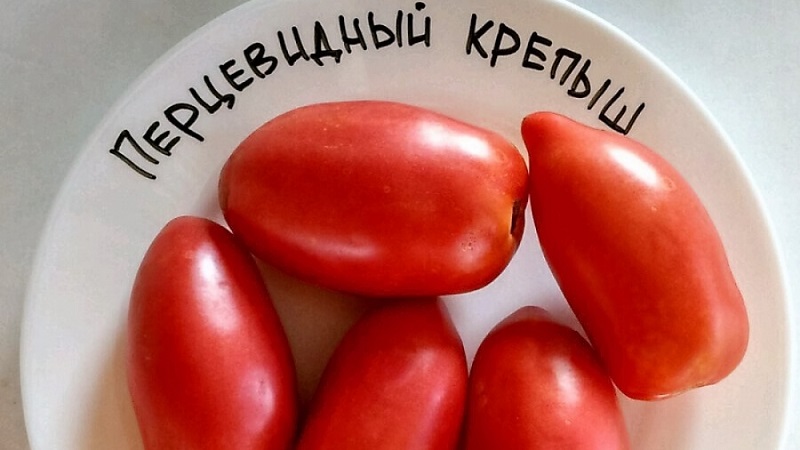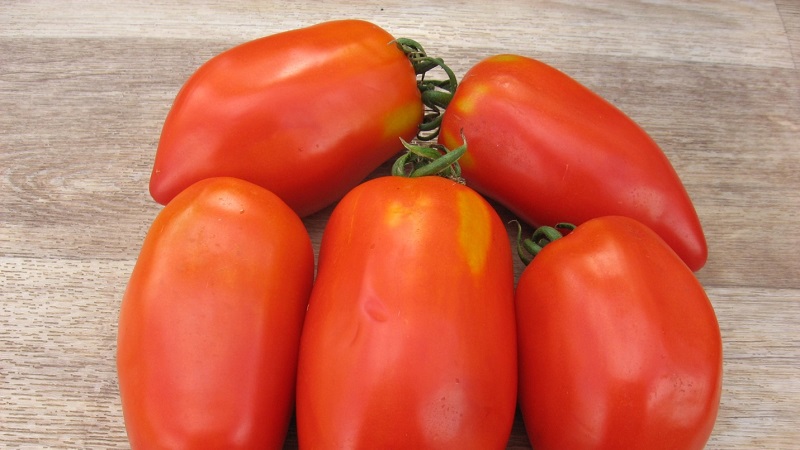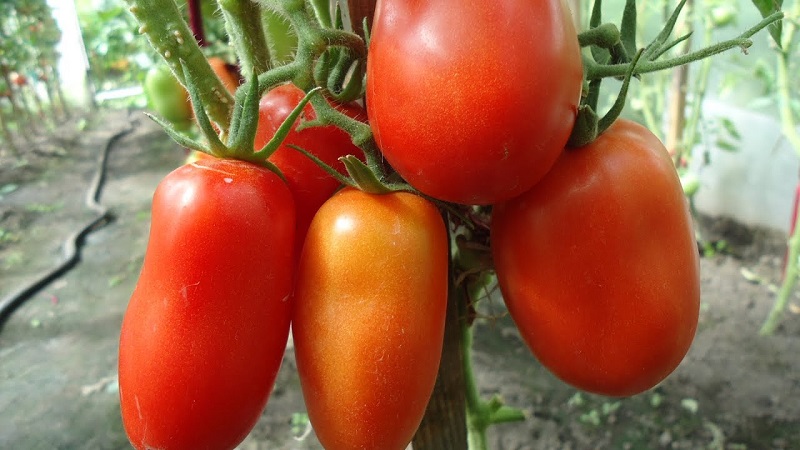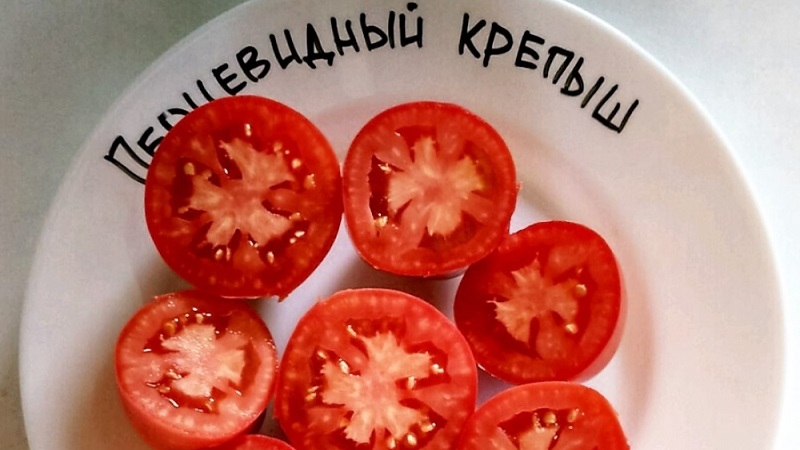Try this unusual variety that will not leave you indifferent - the "Pepper-shaped robust" tomato
Pepper tomatoes have managed to gain well-deserved popularity in Russia both among buyers and among gardeners - from amateurs to experienced breeders. Tomatoes of the Pepper-shaped Sturdy variety have appetizing forms, and they also taste good - juicy, with sweet crumbly pulp and a small amount of seeds.
With all the gastronomic advantages, the main advantage of Krepysh among his relatives in the line of pepper-shaped ones is his unpretentiousness. Even for a novice gardener, the process of cultivating it will not cause much difficulty. A real dream of a gardener and a housewife!
The content of the article
Characteristics and description of the variety
The first pepper-shaped tomatoes were brought to Russia from abroad 20 years ago. A distinctive feature of the variety is the elongated oblong shape of the fruit, reminiscent of bell peppers, which is why they got their name.
In 2001, the State Register of Russia registered the firstborn in this line - the Pepper Tomato. And in 2014 and tomato Pepper-shaped Krepysh.
By the way. A ripe fruit of an oblong shape and a pleasant pink color has a mass of 100-150 g.
Distinctive features
This variety is fully consistent with its name. He is Siberian solid and strong. Bred by breeders of Western Siberia for cultivation in the open field, therefore it is well adapted to cold weather.
Pepper Fortress has undeniable advantages:
- a compact, undersized bush reaches a height of only 30-40 cm, therefore it does not require molding, garters and pinching;
- begins to bear fruit early, 105-110 days from germination;
- disease resistant, immune to many viruses, including TMV (tobacco mosaic virus);
- unpretentious in care (in comparison with other varieties of pepper tomatoes), reacts well to watering and feeding with complex fertilizers.
See in the photo how the Pepper-shaped stalwart looks like.

Fruit characteristics and yield
Fruits of Krepysha are large, weighing 100-150 g. The shape does not exactly repeat the appearance of peppers, but smoother, rounded. Color - from pale pink to deep raspberry. Suitable for both fresh consumption and canning.
The yield relative to other tall varieties of these tomatoes is low - up to 4 kg per 1 sq. m. But this disadvantage is more than compensated by the unpretentiousness of the Fortress. Variety determinant, standard - its growth is limited and goes into the fruiting phase, when the bushes reach 30-40 cm. This significantly reduces the cost of growing it.
Important! Trellis are not required - the bushes are not tied up, they do not need to be leveled and pinned.
How to grow seedlings
In general, the process of growing Strong Pepper is the same as that of other varieties of tomato, but there is a nuance. This is a hybrid variety. Hence, seed from self-grown tomatoes may not retain basic parental characteristics. Seeds need to be purchased. And do it in a reliable and trusted source from a reputable manufacturer.
Seed preparation
They are soaked in diluted aloe juice from 12 hours to a day or treated with a solution of potassium permanganate to kill fungi, viruses and increase plant immunity.
Capacity and soil
It is best to purchase a nutrient substrate for growing in a specialized store. It is usually packaged in paper bags labeled "for tomatoes and peppers." But you can prepare the soil yourself.
It's simple: mix peat, turf, compost and sand in a 2: 1: 1: 0.5 ratio. Add 1 glass of wood ash and a complex fertilizer to a bucket of such a mixture, which will include phosphorus, potassium and nitrogen. Such a substrate contains all the macro- and microelements necessary for the normal development of plants.
Under seedlings prepare small boxes filled with purchased or self-prepared soil.
Sowing
Seeds are planted in the substrate at least 50 days before transplanting to a permanent place. The sowing depth should be no more than 1-2 cm, and the width between the grooves 3-4 cm. The seeds are sprinkled with earth, watered abundantly and covered with foil.
In the future, they must be regularly ventilated - at least once a day. The optimum temperature for germination is 22-25 ° C.
Growing and care
After emergence, the film is removed, the boxes are moved to a well-lit place. When 2-3 leaves appear on the sprouts, they are dived (planted) with small pieces of soil into individual containers as carefully as possible so as not to damage the barely formed root system. Peat pots are best suited for this.
The sun and abundant watering will have a beneficial effect on the development of the root system and plants in general. To harden the seedlings, a week before transplanting to a permanent place in the open field, they are put out on the street for 3-4 hours every day.
How to grow tomatoes
The next crucial moment is transplanting to permanent beds. Depending on the geographical location and climatic features of the area, the disembarkation time ranges from late April to late May. You can carry out simple arithmetic operations.
The vegetative period of the Strong Pepper is 105-110 days. 50 of them or a little more should have passed by the time of transplantation. This means that there are still 55-60 days left before the day of fruit collection.
For example, agrarians of central Russia can safely carry out a transplant at the very beginning of May, because Krepysh is zoned for Siberia. Consequently, somewhere in the Samara or Nizhny Novgorod region, the harvest will ripen at the end of June.
If some liberties are permissible over the time of the Fortress's landing, then with the place they are unacceptable. They are not very suitable and even contraindicated for the seedlings of the area where potatoes, peppers, tobacco, tomatoes or other nightshades were grown in previous seasons. The soil is much more favorable after cabbage, carrots, onions, dill or legumes.
Important! Tomatoes are strongly discouraged from being planted in the soil on which any plants of the Solanaceae family were previously grown.
Landing
Unlike many of its counterparts, pepper and tomatoes in general, Pepper Fortress delivers noticeably less hassle when planting and cultivating. It is planted, as a rule, in open ground - in pre-prepared depressions of the size of peat pots. At the rate of 3-4, maximum 5 plants per 1 sq. m.
The variety is standard, so no garters, trellises or any other structures are required.

Care
The seedlings should be plentifully to water standing water and regularly loosen the topsoil around them. Loosening can be omitted at all, and watering can be performed less often, if mulching is carried out - lay a layer of dry grass, leaves or needles around each plant. It will also almost completely save you from weeding.
Do not forget about fertilizing with mineral fertilizers. The three minerals are most important: nitrogen, phosphorus and potassium. The lack of this or that element can be judged by the appearance of the plants.
Here are the specific signs of a deficit:
- nitrogen - yellowed leaves, elongated stems, the trunk becomes soft, and the veins on the underside of the leaf acquire a bluish tint;
- phosphorus - the stem becomes tough and brittle, and the leaves curl inward, the color of the plant changes to purple;
- potassium - the leaves darken, curl up into a tube, brown spots appear at the edges, forming a border.
Based on this, fertilizers should be selected, making up for the lack of certain mineral elements - one, two or several at once. Make up top dressing you can independently or purchase ready-made in the form of a complex fertilizer.
"Recharge" will not only significantly improve the growth and durability of the bushes, but also the taste of tomatoes. When applying complex fertilizers, strictly adhere to the dosages and recommendations given on the package.
Attention!There are many opinions and disputes about the amount of dressings. But most tomato growers believe that the required minimum is 4 times.
Fertilizing with mineral fertilizers is necessary at least 5 times during the growing season - by applying fertilizers under the root of tomatoes and by spraying the bushes.
The following are the most common complex mineral fertilizers and their main characteristics:
- Ammophos is composed of nitrogen and phosphorus. In stores it is presented in granular form. The advantage of the drug is the absence of chlorine and nitrates. It accelerates the formation of the root system and promotes fruit ripening. It is used both in the process of feeding tomatoes and as the main soil fertilizer.
- Ammofoska contains all 3 minerals, in addition, it contains sulfur, potassium and magnesium, which contributes to additional nutrition of plants. Increases immunity to diseases and ensures the full growth of the culture.
- Diammofoska - complex fertilizer, which, in addition to the main ones, contains 8 additional elements, including iron, zinc and manganese. Well nourishes tired soil, indispensable for greenhouses.
- Nitroammofoska - an efficient fertilizer consisting of nitrogen, phosphorus, potassium and sulfur. Produced in the form of granules, it can be used as spring and summer dressing.
- Nitrophoskacontaining a 3-component composition of mineral fertilizers. Well applicable to any type of soil, promotes intensive plant growth. Fertilizers not only improve the growth and resistance of the bushes, but also the taste of the tomatoes.

Features of cultivation and possible difficulties
The main features of the cultivation of the Pepper Tough One can be described in two words: simplicity and minimalism. Even for a novice amateur gardener, this process will not cause much difficulty.
Diseases and pests
The tobacco mosaic virus (TMV) is a real scourge of all nightshades, a persistent headache for several generations of gardeners. Pepper Fortress is immune even to TMV! Pepper tomato varieties are generally not susceptible to disease. Pests also bypass them, despite all the obvious taste advantages of pepper.
The only problem may be the blackening of the fruit due to excess moisture at a low temperature. it late blight... To prevent this disease, it is better to allocate a sunny and well-ventilated place for landing. A fungicide is used as a processing agent. Recommendations for its use are described in detail in the instructions for the drug.
The nuances of growing in open ground and in a greenhouse
The hybrid was bred for cultivation in the open field, and in Siberia. In addition, the Pepper-shaped robust man is inferior to his tall relatives in terms of yield, i.e. the mass of collected fruits from the same area. Therefore, growing it in greenhouse conditions is to go against common sense.
If Krepysh is planted in greenhouses, then only in temporary ones. After reducing the risk of severe cold snaps, they are dismantled. But during this period, you need to carefully monitor the humidity and temperature, and to avoid late blight, organize ventilation in the greenhouse
Harvesting and application of the crop
The harvest ripens in the middle of summer.The fruits have a sweetish fleshy and crumbly pulp with a small amount of seeds. Therefore, tomatoes of this variety are used to prepare vegetable salads, they are consumed fresh, and they also prepare mashed potatoes and juices for children.
Due to the same features, in combination with a dense skin, the fruits of Krepysh are actively used in baked and stuffed form. They are ideally suited for preservation of whole fruits. It is truly a versatile variety.
Advantages and disadvantages of the variety
To summarize, what is so remarkable about the Pepper-Shaped Man:
- growing technology is as simple as possible compared to other tomatoes;
- fruits can be eaten fresh, stuffed and preserved - the dense structure of the pulp does not allow it to fall apart during the cooking process;
- when preparing tomato juices and puree from fruits, a large yield of the finished product is obtained due to the fleshiness of the fruits;
- in appropriate conditions, they retain not only their taste for a long time, but even their smell;
- tolerate transportation well.
The disadvantages include a relatively low yield per unit area.

Farmers reviews
But what those who have already grown it say about the variety.
Valentina, Moscow: "Tomato Pepper-shaped robust will appeal to all lovers of sweet pink varieties, it makes delicious salads, winter preparations and other vegetable dishes."
Natalia, Ryazan: “A delicious tomato with a dense skin. It does not burst either when ripe or canned. This variety is quite resistant to cold snaps, so a sudden drop in temperature in spring does not frighten young bushes. "
Conclusion
A strong pepper-shaped man is a real find for a summer resident, who is still little familiar with agricultural technology and is only taking the first steps in growing tomatoes. It is enough to adhere to the simple sequence of the operations described above: choose the right seeds and germinate them; grow seedlings and transplant them to the beds. Water and fertilize regularly. That's all.
And at the end - attractive fruits that will find worthy use in the hands of a skilled housewife.